Virendra S. Rathore's Blog
March 5, 2024
Ab Initio – setting the record straight on Ajmer and Ajayraj Chauhan
आजकल चौहानों को लेकर कुछ आधारहीन अतिउत्साहित धारणाएं बार बार उठती है। जैसे कि चौहान वंश मालवों की राजर्षि नामक किसी शाखा से उत्पन्न थे। इस पर हम पीछे एक पोस्ट में विस्तृत खंडन दे चुके हैं। एक और धारणा जिसे इतिहास के कलेवर में प्रस्तुत किया जाता है : अजमेर को अजयपाल चौहान ने 7वीं सदी ईस्वी में बसा दिया था, और 12वीं सदी में केवल यहां राजधानी स्थानांतरित हुई थी।
तो आज इसका भी सत्य जान लेते हैं। चौहान इतिहास को लेकर पृथ्वीराजविजय महाकाव्य की प्रामाणिकता तो सभी के लिए संदेह से परे है। ग्रंथ में चौहानों के मूलपुरुष चाहमान (छठी सदी ईस्वी) से लेकर पृथ्वीराज चौहान तृतीय (12वीं सदी ईस्वी) तक सभी शासकों पर वंशावली क्रमानुसार एक एक कर बात की गई है।
इस ग्रंथ या इसकी टीका में अजयमेरु नगर का नाम अर्णोराज के पिता अजयराज चौहान से पूर्व कहीं भी नही मिलता। अर्णोराज 12वीं सदी मध्य में शासक थे और अजयराज 12वीं सदी के आरंभ में सक्रिय रहे।

इस प्रकार महाकाव्य तो सर्ग 5 के श्लोक 119-20 पर साफ कहता है कि अजयराज ने अजेयमेरु बसाया और उनके कृत्यों से नगर का नाम सार्थक हुआ। अजयराज के बाद फिर काव्य सीधे अर्णोराज के वर्णन पर उतर जाता है।
इसके अलावा समकालीन स्त्रोतों में पृथ्वीराज विजय से पहले बिजोलिया शिलालेख 1169 ईस्वी की वंशावली में भी “अजयराज” नामक शासक है 12वीं सदी में मिलते हैं, उससे पहले नही। हर्षनाथ शिलालेख चूंकि 973 ईस्वी का है, इसमें अजयराज का नाम ही नही है।
इस मिथक का बीज पृथ्वीराज चौहान के 150 वर्षों बाद लिखे ग्रंथ “प्रबंधकोश” में हुई एक त्रुटि है। ये ग्रंथ चौहानों के इतिहास को समर्पित नही था। इसमें दी गई चौहान वंशावली में राजा वासुदेव (कोशानुसार 551 ईस्वी) से लेकर चौथे स्थान पर “अजयराज” का नाम आता है, किंतु 12वीं सदी में पृथ्वीराज प्रथम और अर्णोराज के बीच अजयराज गायब हैं और किसी “अल्हण” का नाम आ जाता है [देखें सिंघी जैन ग्रंथमाला प्रकाशन के परिशिष्ट में दी वंशावली]।
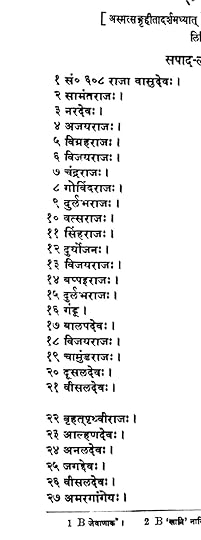
12वीं सदी में अजयराज के ठीक बाद पास ही चौहानों की एक अन्य शाखा के नाडोल राज्य में “अल्हण” नामक शासक मिलते हैं। स्पष्ट है कि प्रबंधकोश के लेखक राजशेखर को उपलब्ध वंशावलियोंं में यहां हेरफेर हुआ है।
यही हाल प्रबंधकोष के 50-60 वर्षों बाद लिखे हम्मीर महाकाव्य का है। वैसे भी 15वीं सदी के किसी ग्रंथ से वंशावलियो के विषय में 12वीं सदी और उससे पीछे के कालखंड पर सटीकता की अपेक्षा करना उचित नहीं।
बाद के इन ग्रंथों की जानकारी पर 20वीं सदी में श्री हरबिलास सारदा ने भी एक गफलत जड़ दी कि अजमेर की कुछ छतरियों में लगे शिलालेखों का समय 8वीं ईस्वी होने से अजमेर की स्थापना इससे पहले ही हुई होगी। दरअसल समीक्षा होने पर ये शिलालेख 8वीं नही बल्कि 18वीं सदी के प्राप्त हुए हैं, अर्थात 8वीं सदी का पठन त्रुटिपूर्ण था [Ancient cities and towns of Rajasthan, KC Jain, Pg 301]।
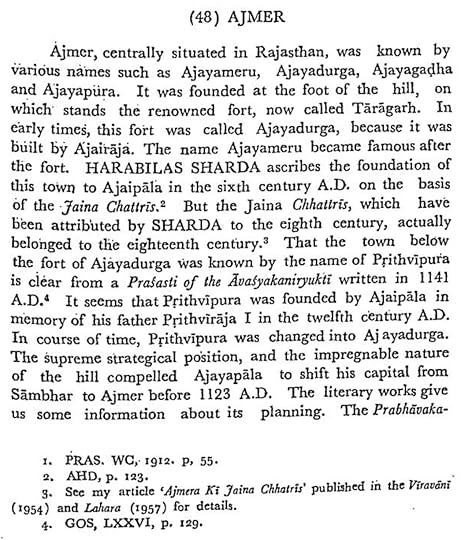
उपरोक्त साक्ष्यों व तर्कों पर ये केवल हमारा मत नही बल्कि श्री दशरथ शर्मा से लेकर विंध्यराज चौहान तक अनेकों विद्वानों का स्पष्ट कथन है।

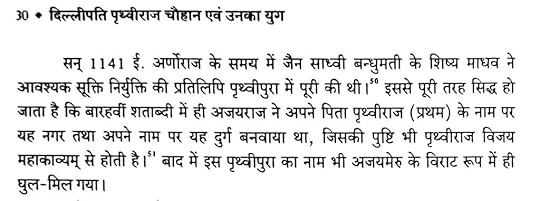
यहां साफ करना होगा कि इतिहास में सुधार संशोधन से गुरेज नहीं है। आवश्यकता केवल इतनी है कि ऐसा उचित साक्ष्यों तर्कों के आधार पर किया जाए। ये असंभव नहीं कि आज के अजमेर की भूमि पर 12वीं सदी से पूर्व कोई मानवीय बस्ती या गतिविधि रही हो। चौहानों की राजधानी का समय के साथ स्थान परिवर्तन या पसराव हुआ हो ये भी स्वीकार्य तथ्य है। लेकिन किसी अजयपाल/अजयराज के नाम पर “अजयमेरु” नाम का एक भरा पूरा नगर 7वीं-8वीं सदी में ही बस गया था ऐसा मानने का कोई विश्वसनीय साक्ष्य उपलब्ध नहीं। ऐसे में इतिहास को इतिहास ही रहने दिया जाए और इसे निजी पूर्वाग्रह या इच्छाओं की पूर्ति का माध्यम ना बनाया जाए तो विद्वजनों की हम सभी पर कृपा होगी। अन्यथा वामपंथी या रामप्यारी ब्रांड के इतिहास विरूपण पर हमारा प्रतिकार ही क्या रह जाएगा।
January 12, 2023
Where and when did Prithviraj Chauhan die?
I have often been asked about where the truth lies regarding the supposed grave of Prithviraj Chauhan in Ghazni. It has grabbed public attention ever since the Sher Singh Rana episode.
Mr. Rana mentions in a facebook live address that Prithviraj killed one of the Ghori brothers (Shahabuddin and Ghiyasuddin) with the shabdavedhi arrow at Damiak, Pakistan near the authentic border at Indian province of Kashmir.
https://www.facebook.com/ranashersingh17/videos/5111009919020537
As Mr. Rana was fumbling while mentioning the exact year of this incident. I couldn’t pin it and have to content with a range of few years just after 1200 AD ( likely 1203/1206 AD).
The testimony of contemporary and near contemporary sources in both Indian and Muslim traditions exposes the glaring gaps in his statements. Some of the points to prove that our King died in Ajmer :
None of the contemporary and near-contemporary muslim sources like Taj-ul-Maasir and Jawami-ul-Hiqayat, etc mention Prithviraj being in Ghazni ever. They either mention his death around the battlefield of Tarain, or in Ajmer. Most importantly they put his demise immediately or soon after the battle of 1192 AD, not 10_15 years later.On the Indian side again, near-contemporary Jain sources ‘Kanyanayaniya Mahavir Pratima Kalpa’ and ‘Prabandha Chintamani’ point us towards death in Ajmer.Hammir Mahakavya also says that Prithviraj’s younger brother Hariraj did the last rites of fallen hero, which again suggests death in Ajmer and not Ghazni for sure. Hariraj had succeeded Prithviraj on the Ajmer throne. Dhili genealogy tells us that Ghori won Delhi from Tomars within weeks of winning Tarain. Muslims sources also mention few others places/outposts around Tarain that the muslim armies occupied after the Tarain battle, as part of consolidating the gains.Amidst all this, where did Ghori have the time to : 1) leave India, go back to Ghazni with Prithviraj, 2) torture and kill Prithviraj and 3) then come back to India, launch another campaign to take Delhi. Considering the logistics and marching pace of 12th century armies, it is simply impossible.
It is also baffling and beyond reason to assume that an important Indian King was in captivity of Ghurids from 1192 AD to 1203/06 AD. Yet no source mentions about this longer than a decade’s captivity of his, not even the Raso which takes him to Ghazni by the way.
Whether Ghori wanted to negotiate with Prithviraj, torture him or kill him. All of these could easily be done while he was staying in India. He didn’t need to lose his momentum in India after a much-awaited & spectacular victory. It was time to solidify the precious gains and not illogically sprint back home. That is what the smart and wily Shahabuddin did as well.
What we just said finds a very close precedent. When Ghori had earlier got hold of the last Ghaznavid royalty in Lahore by deceit. He didn’t escort them to Ghazni personally. He had them sent to Ghazni as captives (killed later), while Ghori himself stayed back in the Punjab region to consolidate his gains.
Then what about the supposed grave of Prithviraj Chauhan in Ghazni?
Polarizing narratives have their own needs. It was a public motivational resource for local muslim powers in Afghanistan to propagate Prithviraj as a beaten kafir foe to spit upon. Such needs necessitate the creation of their own memories and they need not conform to the plain old vanilla truth.
We see similar trajectory in India where on one side the ‘char bans chaubis gaz’ echoes even today. While on the other you would see numerous graves with dubious to no historical tracking in/around Bahraich. These are touted as being the remains of Ghazis who fought with Salar Masud in the iconic battle of Bahraich, while muslim forces are said to had a devastating defeat with hardly any survivors, just like Tarain-II for Rajputs.
It is also said wrongly by Mr. Rana that upon being captured in the first battle of Tarain, Ghori says that he was just the deputy of his elder brother the Sultan and was simply following orders.
This utterance of Ghori is found only in Ferishta’s account which comes 400 years after the events. There as well Ghori makes this statement only just before the second battle of Tarain when both armies were pitched in camps against each other and indulging in diplomacy. It wasn’t same d by Ghori after his defeat and the supposed capture in the first battle of Tarain as Mr. Rana claims.
There are multiple reasons why Prithviraj did not pardon Ghori in the first battle of Tarain and we have covered them in our book. One of them relates to the Indian outpost of Sarhind which Ghori captured just before Tarain’s first battle.
Ghori had placed a garrison of 1200 soldiers in Sarhind fort under Ziauddin Tolaki and asked him to hold the fort till he comes back from Ghazni. Things didn’t go per plan when the Rajput armies arrived swiftly and Ghori had to turn back from his return journey to face them.
If Ghori was captured in Tarain-I, then obviously Prithviraj Chauhan would demand from Ghori to first empty the Sarhind fort of his garrison. Shahabuddin Ghori, then at mercy of Prithviraj, would have readily obliged in order to live [ By the way, fall of Sarhind outpost was the trigger of both the Tarain battles ].
History however tells us differently. We know from contemporary/near-contemporary sources that the Ghurid garrison at fort of Sarhind didn’t vacate. It was under siege for months even after the battle of Tarain-I. Per Tabaqat-i-Nasiri, the garrison fell only few months before Ghori returned to India for the second battle of Tarain. It means that in Tarain-I, Ghori wasn’t even captured that the question of pardon or meeting such demands would arise.
Based on multiple muslim sources, it seems that post Tarain-I the Rajputs had chased the fleeing Ghurids for 40 miles up to the Sutlej river where the border was back then.
At the same time of 15-16th centuries’ junction when Raso was gaining mainstream popularity, Ferishta too was writing a comprehensive history of Muslim dynasties. He covers the history of Prithviraj, Ghori and Tarain episodes etc. Yet Ferishta makes no mention of Shahabuddin’s or Ghiyasuddin’s death at the hands of Prithviraj Chauhan. He writes of Prithviraj being captured and executed not far from Tarain.
Summing up the sources forms an interesting picture. In terms of the lifespan and death of important figures, muslim sources present a more consistent picture throughout the centuries. Centuries after Tarain, with the arrival of Mughals, the Indian sources (like Raso) however diverge in a big way from their predecessor accounts’ narrative.
Considering the above evidences, it is clear that Prithviraj Chauhan wasn’t taken to Ghazni. Accordingly the remaining assertions of Raso and Mr. Rana are questionable at the least.
Mr. Rana is also at pains that people question shabdavedhi bana incident and consequently the greatness of Prithviraj as well. His subsequent emphasis on connecting the shabdavedhi bana and greatness, betrays a constraint that for Prithviraj Chauhan to be great, he must fire the shabdavedhi bana or else all is lost. I don’t know whose compelling reasons necessitate this portrayal. Because there is plenty in the life of Prithviraj which is more factual than the shabdavedhi and which also makes him great.
Mr. Rana then continues that Raso’s author Chandavardai must have gone to Dhamiak/Ghazni looking for Prithviraj after more than 10 years of the captivity since the 2nd battle of Tarain. This fiercely violates against the nature of close relationship between Prithviraj and Chandavardai, as depicted in the latter’s Prithviraj Raso. In the Raso, Chandarvardai’s journey takes place immediately after the battle and captivity of the King. He is shown desperate to reach Prithviraj and undertakes an arduous trip of more than 30 days disregarding thirst and hunger. Are we supposed to believe this best friend of Prithviraj forgot about him for 10-12 years before the resurgance of a sudden emotional outburst?
After arguing that Shahabuddin’s tomb is in a jail within the kot Dhamiak because he died there only at the hands of captive Prithviraj. Mr. Rana then also guesses that the King killed by Prithviraj’s shabdavedhi could have been Ghiyasuddin!
Can we please be sure of who he killed. In any case, no source of history mentions Ghiyasuddin to have died at Dhamiak/Ghazni at the hands of a kafir King. His tomb is in Herat from where he ruled. Muslim chroniclers consistently maintain that Ghiyasuddin managed in the north and west while Shabuddin in the south and east (toward India). Going by the great logic of tombs by Mr. Rana (that they’re built exactly where the person died), shall we shift Prithviraj to Herat as well now?
Coming to Mr. Rana’s repeated argument that there used to be a jail in the fort and why would the Ghurid Sultan be buried in jail if he hadn’t died there (supposedly at the hands of Prithviraj).
There is no evidence to indicate that such a jail was operative in that Fort during the time of Ghiyasuddin or Shahabuddin Ghori. If it was, then the last Ghaznavid royalty captured by Shahabuddin in 1180s would have been sent to Dhamiak and not Ghazni as the case is.
Mr. Rana also states that since Shahabuddin Ghori was called a shahid, so he must have been killed by a kafir and hence Prithviraj Chauhan. I don’t know why he forgets that Ghori’s death as recorded in muslim sources is at the hands of a band of Kokhar assassins who then happened to dwell in good numbers in both faiths – Hindu and Muslim.
Numerous sources on both sides clearly state that Prithviraj Chauhan had died in 1192 AD, including the earliest Indian sources like Prabandha Chintamani and KanyaNayaniya Mahavir Pratima Kalpa. Despite this, Mr. Rana keeps stressing without evidence that the Ajmer King died in 1203 or 1206 AD.
How far are we going to stretch things, just to buttress the narrative that we want to tell the world. Has truth become so inimical to tell?
December 28, 2022
Where and when did Prithviraj Chauhan die?
I have often been asked about where the truth lies regarding the supposed grave of Prithviraj Chauhan in Ghazni. It has grabbed public attention ever since the Sher Singh Rana episode.
Mr. Rana mentions in a facebook live address that Prithviraj killed one of the Ghori brothers (Shahabuddin and Ghiyasuddin) with the shabdavedhi arrow at Damiak, Pakistan near the authentic border at Indian province of Kashmir.
https://www.facebook.com/ranashersingh17/videos/5111009919020537
As Mr. Rana was fumbling while mentioning the exact year of this incident. I couldn’t pin it and have to content with a range of few years just after 1200 AD ( likely 1203/1206 AD).
The testimony of contemporary and near contemporary sources in both Indian and Muslim traditions exposes the glaring gaps in his statements. Some of the points to prove that our King died in Ajmer :
None of the contemporary and near-contemporary muslim sources like Taj-ul-Maasir and Jawami-ul-Hiqayat, etc mention Prithviraj being in Ghazni ever. They either mention his death around the battlefield or in Ajmer, and most importantly they put it immediately after .On the Indian side again, near contemporary Jain sources ‘Kanyanayaniya Mahavir Pratima Kalpa’ and ‘Prabandha Chintamani’ point us towards death in Ajmer.Hammir Mahakavya also says that Prithviraj’s younger brother Hariraj did the last rites of fallen hero, which again suggests death in Ajmer and not Ghazni for sure. Hariraj had succeeded Prithviraj on the Ajmer throne. Dhili genealogy tells us that Ghori won Delhi from Tomars within weeks of winning Tarain. Muslims sources also mention few others places/outposts around Tarain that the muslim armies occupied after the Tarain battle.Amidst all this, where did Ghori have the time to leave India, go back to Ghazni. Torture and kill Prithviraj and then come back to India, launch another campaign to take Delhi. Considering the logistics and marching pace of 12th century armies, it is simply impossible.
It is baffling and beyond reason to assume that an important Indian King was in captivity of Ghurids from 1192 AD to 1203/06 AD. Yet no source mentions about this longer than a decade’s captivity of his, not even the Raso which takes him to Ghazni by the way.
Whether Ghori wanted to negotiate with Prithviraj, torture him or kill him. All of these could easily be done while he was staying in India. He didn’t need to lose his momentum in India after a spectacular victory. It was time to solidify the precious gains and not illogically sprint back home. That is what the smart and wily Shahabuddin did as well.
What we just said finds a very close precedent. When Ghori had earlier got hold of the last Ghaznavid royalty in Lahore by deceit. He didn’t escort them to Ghazni personally. He had them sent to Ghazni as captives (killed later), while Ghori himself stayed back in the Punjab region to consolidate his gains.
Then what about the supposed grave of Prithviraj Chauhan in Ghazni?
Polarizing narratives have their own needs. It was a public motivational resource for local muslim powers in Afghanistan to propagate Prithviraj as a beaten kafir foe to spit upon. Such needs necessitate the creation of their own memories and they need not conform to the plain old vanilla truth.
We see similar trajectory in India where on one side the ‘char bans chaubis gaz’ echoes even today. While on the other you would see numerous graves with dubious to no historical tracking in/around Bahraich touted as being the remains of Ghazis who fought with Salar Masud in the iconic battle of Bahraich.
It is also said wrongly by Mr. Rana that upon being captured in the first battle of Tarain, Ghori says that he was just the deputy of his elder brother the Sultan and was simply following orders.
This utterance of Ghori is found only in Ferishta’s account which comes 400 years after the events. There as well Ghori makes this statement only just before the second battle of Tarain when both armies were pitched in camps against each other. Not after his defeat and supposed capture in the first battle of Tarain as Mr. Rana claims.
There are multiple reasons why Prithviraj did not pardon Ghori in the first battle of Tarain and we have covered them in our book. One of them relates to the Indian outpost of Sarhind which Ghori captured just before Tarain’s first battle.
Ghori had placed a garrison of 1200 soldiers in Sarhind fort under Ziauddin Tolaki and asked him to hold the fort till he comes back from Ghazni. Things didn’t go per plan when the Rajput armies arrived swiftly and Ghori had to turn back from his return journey to face them.
If Ghori was captured in Tarain-I, then Prithviraj Chauhan would have first asked him to empty the Sarhind fort of his garrison. Shahabuddin Ghori then at mercy of Prithviraj would have readily obliged in order to live. Fall of Sarhind was by the way trigger of both the Tarain battles.
History however tells us differently. The Ghurid garrison at fort of Sarhind was under siege for months after the battle of Tarain-I. Per Tabaqat-i-Nasiri, the garrison fell only few months before Ghori returned to India for the second battle of Tarain. Which means that in Tarain-I, Ghori wasn’t even captured that the question of pardon would arise. Based on multiple muslim sources, it seems that post Tarain-I the Rajputs had chased the fleeing Ghurids for 40 miles up to the Sutlej river where the border was back then.
At the same time of 15-16th centuries’ junction when Raso was gaining mainstream popularity, Ferishta too was writing a comprehensive history of Muslim dynasties. He covers the history of Prithviraj, Ghori and Tarain episodes etc. Yet Ferishta makes no mention of Shahabuddin’s or Ghiyasuddin’s death at the hands of Prithviraj Chauhan. He writes of Prithviraj being captured and executed at Ghori’s orders.
Summing up the sources forms an interesting picture. In terms of the lifespan and death of important figures, muslim sources present a more consistent picture throughout the centuries. But centuries after Tarain, with the arrival of Mughals, the Indian sources (like Raso) however diverge in a big way from their predecessor accounts’ narrative.
Considering the above evidences, it is clear that Prithviraj Chauhan wasn’t taken to Ghazni and accordingly the rest which Raso and Mr. Rana suggest is also questionable at the least.
Mr. Rana is also at pains that people question shabdavedhi bana incident and consequently the greatness of Prithviraj as well. His subsequent emphasis on connecting the shabdavedhi bana and greatness, betrays a constraint that for Prithviraj Chauhan to be great, he must fire the shabdavedhi bana or else all is lost. I don’t know which or whose compelling reasons necessitate this. Because there is plenty in the life of Prithviraj which is more factual than the shabdavedhi and which also makes him great.
Mr. Rana then continues that Raso’s author Chandavardai must have gone to Dhamiak/Ghazni looking for Prithviraj after more than 10 years of the captivity since the 2nd battle of Tarain. This fiercely violates against the nature of close relationship between Prithviraj and Chandavardai, as depicted in the latter’s Prithviraj Raso. In the Raso, Chandarvardai’s journey takes place immediately after the battle and captivity of the King. He is shown desperate to reach Prithviraj and undertakes an arduous trip of more than 30 days disregarding thirst and hunger. Are we supposed to believe this best friend of Prithviraj forgot about him for 10-12 years before this sudden emotional outburst?
After arguing that Shahabuddin’s tomb is in a jail within the kot Dhamiak because he died there only at the hands of captive Prithviraj. Mr. Rana then also guesses that the King killed by Prithviraj’s shabdavedhi could have been Ghiyasuddin. Can we please be sure of who he killed. In any case, no source of history mentions Ghiyasuddin to have died at Dhamiak/Ghazni at the hands of a kafir King. His tomb is in Herat from where he ruled. Going by the great logic of tombs by Mr. Rana (that they’re built exactly where the person died), shall we shift Prithviraj to Herat as well now?
Coming to his repeated argument that there used to be a jail in the fort and why would the Ghurid Sultan be buried in jail if he hadn’t died there (supposedly at the hands of Prithviraj).
There is no evidence to indicate that such a jail was operative in that Fort during the time of Ghiyasuddin or Shahabuddin Ghori. If it was, then the last Ghaznavid royalty captured by Shahabuddin in 1180s would have been sent to Dhamiak and not Ghazni as the case is.
Mr. Rana also states that since Shahabuddin Ghori was called a shahid, so he must have been killed by a kafir and hence Prithviraj Chauhan. I don’t know why he forgets that Ghori’s death as recorded in muslim source is at the hands of a band of Kokhar assassins who then happened to dwell in good numbers in both faiths – Hindu and Muslim.
Numerous sources on both sides clearly state that Prithviraj Chauhan had died in 1192 AD, including the earliest Indian sources like Prabandha Chintamani and KanyaNayaniya Mahavir Pratima Kalpa. Despite this, Mr. Rana keeps stressing without evidence that the Ajmer King died in 1203 or 1206 AD.
How far are we going to stretch things, just to buttress the narrative that we want to tell the world. Has truth become so inimical to tell?
December 27, 2022
Are Chauhans originated from Malavas ?
क्या चौहानों का उद्भव मालवों से है?
चौहानों को मालव क्षत्रियों से जोड़ने पर श्री विंध्यराज चौहान आदि कुछ विद्वानों ने अपने मत रखे हैं। चौहानों के मूलपुरुष “चाहमान” छठी सदी ईस्वी के मालवदेशीय क्षेत्रियों के समकालीन थे और उनके सामंत या सहयोगी रहे इतना तो लगभग निश्चित है। इसके लिए चौहानों की वंशावलियां, चाहमान के तत्कालीन राजनैतिक भूगोल और पृथ्वीराजविजय के उल्लेख हमें पर्याप्त बिंदु देते हैं, जिसपर पृथ्वीराज चौहान पर आधारित पुस्तक में भी लिखा गया है।
लेकिन मालव क्षत्रिय वंश/ जनजाति से चौहानों का निकास होने का हमें अपने अध्ययन में कोई ठोस साक्ष्य नहीं मिला। पर कुछ लोग आजकल इसे पत्थर की लकीर मानकर चलने लगे हैं कि पंजाब से आते मालवो की ही एक शाखा “चौहान” नागौर अजमेर क्षेत्र में आकर बसे थे ।
जिन बिंदुओं को गिनाकर ये दावे किए जाते हैं, एक-एक कर हम उनका आंकलन कर लेते हैं, और तथ्यों सहित उन दावों का उत्तर भी देंगे ।
दावा #1: नान्दसा यूप स्तम्भ लेख की निम्नलिखित 5वीं पंक्ति का अर्थ है “इक्ष्वाकु प्रथित मालववंश के राजर्षि वंश में जन्मे चौहान” – इक्ष्वाकु प्रथित राजर्षि वंशे मालव वंशे.……
दावा #2: बड़ल्या वापी शिलालेख वि.स. 1234, सन् 1177 ई० के दूसरे श्लोक में लिखा है – “चाहमानाह्रपः कोपिपुरा वीरो विरोचनात प्रादुर्व्व(र्ब्ब)भूव {राजर्षि पृथिव्यामरि मर्दनः}||2||
अर्थात् प्राचीनकाल में ‘राजर्षि’ ‘विरोचन’ का मातृभूमि के शत्रुओं का, मानमर्दन करने वाला “चाहमान” नामक पुत्र हुआ ।
उत्तर: प्रथम तो नान्दसा यूप स्तम्भ लेख मध्यकालीन मालवदेश के निकट दक्षिण पूर्वी राजस्थान के भीलवाड़ा से मिलता है । इसकी उपरोक्त पंक्ति में इक्ष्वाकु प्रथित से अर्थ “इक्ष्वाकुओं से निकले” लिया जाए या “इक्ष्वाकु के जैसे प्रसिद्ध”, इसी पर विद्वान एकमत नहीं हैं । दूसरी बात, पंक्ति में दरअसल इक्ष्वाकु – जैसे प्रसिद्ध / से निकले – राजर्षियों द्वारा चलाए मालववंश के राजा नंदीसोम सोगिन का उल्लेख है। चौहानों का या उनके मूलपुरुष चाहमान का उल्लेख इस अभिलेख में कहीं नही मिलता । तो चौहानों के उत्पत्ति से मालव होने के साक्ष्य के रूप में इस शिलालेख का उपयोग क्यों किया जा रहा है? दरअसल सोगिनों के नांदसा अभिलेख और चौहानों के बड़ल्या अभिलेख, इन दोनों में मिले “राजर्षि” शब्द के आधार पर ये कहने का प्रयास है कि चौहान लोग मालवों में “राजर्षि” नामक कोई शाखा थी और उसी से चौहान निकले हैं ।
तथ्य इस प्रकार है कि ‘राजर्षि’ शब्द बहुत ज्ञानी क्षत्रिय राजाओं के लिए इतिहास में कई बार उपमा की तरह प्रयुक्त हुआ है। रामायण कालीन विश्वामित्र जी से लेकर ऋषि मुद्गल, चंद्रवंशी पुरुरवा, कार्तवीर्य आदि कई को राजर्षि कहा गया है ।
 [Matysa Purana 13.62]
[Matysa Purana 13.62]
 [Matysa Purana 43.23]
[Matysa Purana 43.23]महाभारत में नकुल से भिड़े आक्रोश को राजर्षि कहा गया है । ऐसे ही प्रतिहारों की एक शाखा ने भी अपने मूलपुरुष हरिश्चंद्र को ‘गुरु’ की संज्ञा दी है ।
नान्दसा अभिलेख में ‘राजर्षि वंशे’ से अर्थ ‘ज्ञानी लोगों का चलाया राजवंश’ है, ना कि राजर्षि नामक कोई वंश/शाखा । इस अभिलेख में मालवों की राजर्षि नामक कोई शाखा होने का उल्लेख तो नहीं है, बल्कि ‘सोगिन’ नामक शाखा का उल्लेख स्पष्ट रूप से किया गया है (संभवतः सौगि ऋषि गोत्र के कारण) । अभिलेख :
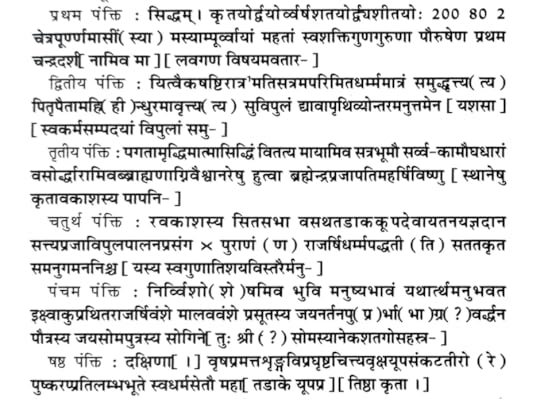 [ Nandsa Inscription, EI 27, Pg 252 ]
[ Nandsa Inscription, EI 27, Pg 252 ]12वीं सदी के बड़ल्या वापी शिलालेख की ओर चलेंगे । ये खंडित श्रेणी में आता है, क्योंकि जिस शिला पर ये अंकित है वो दांयी ओर से टूटी हुई है । खंडन का कोण देखने और अंकन के लयबद्ध होने से अनुमान लग जाता है कि पहली पंक्ति में लगभग 16 अक्षरों का लोप हुआ है और नीचे की पंक्तियों में नुकसान कम होता जाता है । इस शिलालेख के दूसरे श्लोक में दावे अनुसार बताए गए शब्द “{राजर्षि पृथिव्यामरि मर्दनः}” किसने किस आधार पर माने है, ये मुझे फिलहाल ज्ञात नहीं । पर Epigraphia Indica में मूल शिला के प्रकाशन से लेकर श्री दशरथ शर्मा, विंध्यराज चौहान और रामवल्लभ सोमानी की पुस्तकों में पंक्ति जैसी मिलती है, वो नीचे दी जा रही है । और इन सभी प्रकाशनों में कहीं भी “{राजर्षि पृथिव्यामरि मर्दनः}” शब्द नहीं मिलते :
 [ Early Chauhan Dynasties – Dasharatha Sharma ]
[ Early Chauhan Dynasties – Dasharatha Sharma ]
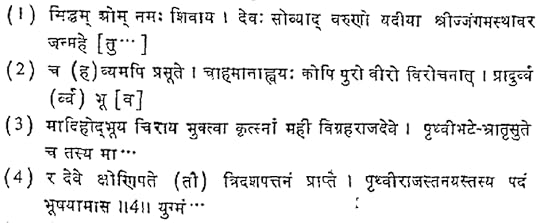 [ Prithviraj Chauhan and his Times – R V Somani ]
[ Prithviraj Chauhan and his Times – R V Somani ]

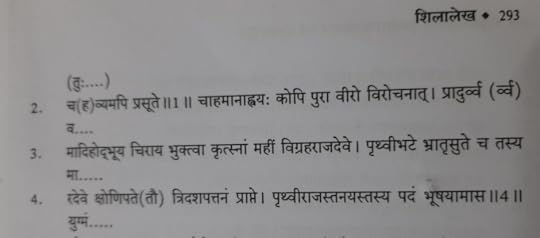 [ Dillipati Prithviraj Chauhan aur unka Yug – Vindhyaraj Chauhan ]
[ Dillipati Prithviraj Chauhan aur unka Yug – Vindhyaraj Chauhan ]
 [ Epigraphia Indica vol 32 ]
[ Epigraphia Indica vol 32 ]यदि किसी ने हाल ही में मूल शिला का फिर से पठन किया और इसका लुप्त शिलाखंड ढूंढ लिया हो, तो किसी पुरातत्व पत्रिका में समीक्षा हेतु अभिलेख का नए सिरे से पुनः प्रकाशन हुआ ऐसा मेरी दृष्टि में नहीं आया है । किसी को मिले तो अवश्य साझा करें ।
ध्यान दें कि पहला श्लोक जो कि अधूरा है, समाप्त होते समय “प्रसूते” (जन्म लिया) शब्द आया है| इससे संकेत मिलता है कि श्लोक की पहली पंक्ति के उन 16 लुप्त अक्षरों में चौहान की उत्पत्ति पर जानकारी दी गयी हो । तदनुसार इसके ठीक बाद दूसरे श्लोक में चौहानों के मूलपुरुष चाहमान और उनके पिता विरोचन का नाम आना स्वाभाविक है । “विरोचन” शब्द से यहाँ विंध्यराज जी के कथनानुसार चाहमान के अनुवांशिक पिता (व्यक्ति) माना जाए, या फिर शब्द को सूर्यदेव का पर्यायवाची मानें, इस बहस में हम नहीं पड़ेंगे ।
पर विरोचन और चाहमान के नाम आ जाने के बाद फिर से चौहानों की उत्पत्ति पर पीछे की ओर जाकर उन्हें मालव राजर्षि कहा गया हो, ये सूचना क्रम में यथासंगत नहीं लगता । क्योंकि मूल पठन में विरोचन और चाहमान के बाद केवल एक अनुपलब्ध/अपाठ्य अंश है और फिर तीसरे श्लोक में सीधे विग्रहराज चौहान (चतुर्थ) और उनके भतीजे पृथ्वीभट का नाम आ जाता है ।
विग्रहराज के नाम से पहले (पंक्ति #3 में) चूंकि “क्रमात् इह उद्भूय” शब्द आए हैं, अर्थात “इस क्रम में पैदा हुए” । इससे अनुमान होता है कि ठीक पहले के लुप्त भाग में मालवों के किसी तथाकथित राजर्षि वंश से चौहानों की उत्पत्ति जताने के बजाय चाहमान और विग्रहराज चतुर्थ के बीच के कुछ चौहान राजाओं के नाम रहे होंगे ।
एक बार के लिए “{राजर्षि पृथिव्यामरि मर्दनः}” को लेकर उस आधार पर विरोचन को राजर्षि मान भी लें, तो जैसा कि हमने पीछे कहा, “राजर्षि” केवल एक प्रशंसात्मक उपमा है किसी वंश या शाखा का नाम नहीं । ना ही अभिलेख की पंक्तियों से ऐसा सोचने का आधार मिलता है ।
दावा #3: चन्द्रमहासेन चौहान के धौलपुर शिलालेख वि.स. 898 में ही सबसे पहले विक्रम संवत्सर का ऐसा नाम लेकर उसका प्रयोग हुआ है| विक्रम सम्वत मालव सम्राट विक्रमादित्य के नाम से है । फिर 12वीं सदी के पृथ्वीराज (द्वितीय) ने अपने मेनाल शिलालेख में मालवेश संवत् का प्रयोग किया है ।
उत्तर: ये सत्य है कि धौलपुर शिलालेख में “विक्रम” सम्वत को पहली बार इस नाम से लिखा गया है जबकि इससे पूर्व इसी सम्वत को कृत, मालव, या मात्र सम्वत ही लिख दिया जाता था । पर केवल एक चौहान राजा के द्वारा एक प्रचलित सम्वत को 900 वर्षों पूर्व के मालव-देशीय राजा (विक्रमादित्य) के नाम से पहचानने के बल पर चौहानों को उत्पत्ति से मालव कह देना – एक कमज़ोर तर्क है ।
बहुत से राजाओं के काल में गुप्त और हर्ष आदि संवतों का प्रयोग भी हुआ है, जबकि उन राजाओं का गुप्त वंश या सम्राट हर्षवर्धन से कोई अनुवांशिक सम्बन्ध नहीं था । राजनैतिक शक्तियों के द्वारा प्रयोग किए गए संवत कैसे हैं और या केवल सिक्कों आदि की समानता से अनुवांशिक या अन्य महत्त्वपूर्ण निष्कर्ष निकालने लगें तो प्रतिहार हूण सिद्ध हो जाएंगे, और शहाबुद्दीन गोरी को लक्ष्मी के सिक्कों से हिंदू हितैषी कहना होगा । सम्वत और सिक्के राजनैतिक विरासत का भाग होते हैं, जिसे शासन तंत्र की सुविधा के लिए अक्सर जारी रखा जाता है; चाहे आपका उस सम्वत/सिक्के की संरचना, या मौलिक पृष्ठभूमि के लोगों से सीधा जुड़ाव हो या नहीं ।
जिस समय धौलपुर शिलालेख आया है, तब मालव क्षेत्र में परमारों की दूसरी पीढ़ी राज कर रही थी । इन्हे पूरे मध्यकाल में मालव कहा गया है, चौहानों द्वारा भी । इन परमारों का किसी तथाकथित प्राचीन मालव वंश/जनजाति से उद्गम होने का कोई साक्ष्य नहीं है । उससे भी पहले छठी और सातवीं सदी (हर्षवर्धन काल सम्मिलित) में “मालव” पहचान गुप्त वंशी राजाओं को प्राप्त थी । इनका भी प्राचीन मालवों से कोई अनुवांशिक साम्य नहीं मिलता; और ना ही इन गुप्तवंशियों के नाम प्राचीन मालवों के नंदीसोम, यशोधर्मन आदि से समानता रखते हैं – देवगुप्त, कुमारगुप्त माधवगुप्त । हर्षचरित के कुछ उदाहरण :



दावा #4: विग्रहराज चौहान चतुर्थ का निम्लिखित शिलालेख वि.स. 1210-20 (12वीं सदी ईस्वी), चौहानों को मालव कहता है (दूसरी पंक्ति)-
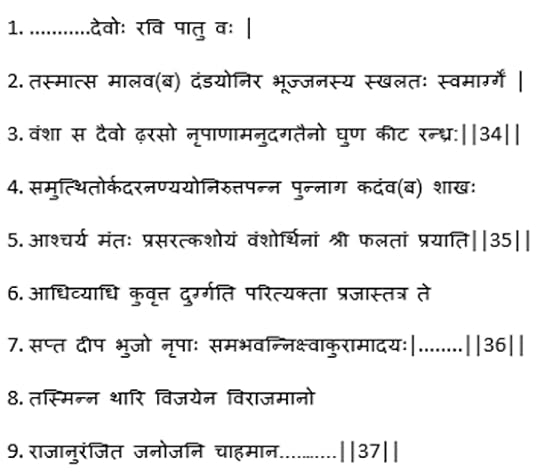
दावे में पंक्तियों का अर्थ इस प्रकार दिया गया है :
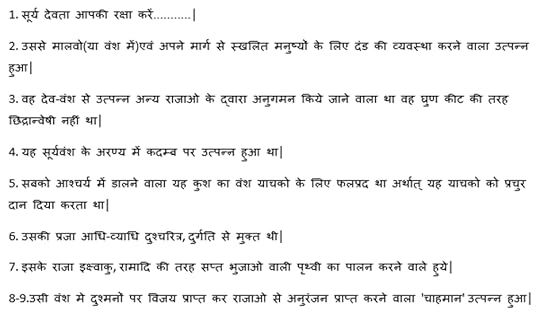
उत्तर : विग्रहराज चौहान चतुर्थ के काल में शिलाओं पर “ललितविग्रहराज नाटिका” के साथ ही उपरोक्त वंश प्रशस्ति भी उकेरी हुई मिलती है । पर यहाँ फिर से शब्दों का खेल हुआ है| हमारे विषय के लिए आरम्भ की पंक्तियाँ ही महत्वपूर्ण हैं ।
दावे की दूसरी पंक्ति में जिसे “तस्मात्स मालव(ब) दंडयोनिर भूज्जनस्य” लिखकर चौहानों को मालव बता दिया गया है, वो वास्तव में “तस्मात् समालम्बन दंड यो निरभूज्जनस्य” है ।
तस्मात् – अतएव therefore
समालम्बन – उत्तम आधार good base
दंड – शासन का बल / साधन / प्रतीक sceptre / symbol of power (exertion)
यो – कौन / जो कि he who
निरभूज्जनस्य – भटके हुए लोगों के of the distracted people
स्खलतः – फिसलन, अपने स्थान से च्युत होना
स्वमार्गे – अपने मार्ग में
अर्थात राजा को अपने मार्ग में फिसलकर भटके हुए लोगों (प्रजा) के लिए सुशासन रूपी आधार बताया गया है ।
हम “तस्मात् समालम्बन” को यदि “तस्मात्स मालव(ब)” भी मान लें तो पूरी पंक्ति 2 में दावे की व्याख्या अनुसार “दंड की व्यवस्था करने वाला उत्पन्न हुआ” जैसा अर्थ प्रकट करने योग्य कोई शब्द ही नहीं बचता और पूरा वाक्य बेतुका हो जाता है ।
ये गफलत किसी इंटरनेट-वीर की है या लेखक की, मैं नहीं जानता | यहाँ शिलालेख का मूल पाठ जैसा कि गौरीशंकर हीराचंद ओझा जी से प्राप्त है, साझा किया जा रहा है :
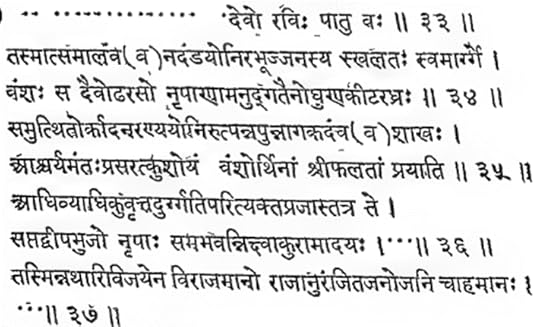 [ Rajputane ka Itihas-1, G. H. Ojha ]
[ Rajputane ka Itihas-1, G. H. Ojha ]मालवों के बारे में कहा जाता है कि मालव नामक कोई वंश/जनजाति थी जिन्होंने पंजाब से केंद्रीय भारत में पलायन कर अपने नाम से मालवदेश (मालवा) बसाया | पर ये धारणा सिद्ध नहीं है | ग्रीक विद्वानों द्वारा पंजाब में देखे गए “मल्लोई” लोगों को ब्रिटिश काल में भंडारकर आदि की मान्यता से ज़बरदस्ती केंद्रीय भारत के मालव (देशीय) क्षत्रियों से जोड़ दिया गया ।
इस जुड़ाव की पड़ताल करें तो पाएंगे कि केंद्रीय भारत (मालवदेश – मालवा) के किसी भी मध्यकालीन शासक/वंश ने अपने अभिलेखों में कभी स्वयं को पंजाब से उठा नहीं बताया, और ना ही अपने आप को कभी उत्पत्ति से मालव कहा ।
मालव शब्द युक्त कोई भी प्राचीन शिलालेख पंजाब क्षेत्र से नहीं मिलता ।
पहला अभिलेख पश्चिमी क्षत्रपों के अंतर्गत सामंत उषवदात का नासिक से है, जिसमें (विद्वजनानुसार मालय को मालव मानें तो) पुष्कर, अजमेर के आसपास रहते उत्तमभद्रों पर मालवों के आक्रमण और क्षत्रपों द्वारा उत्तमभद्रों की सहायता का उल्लेख है ।
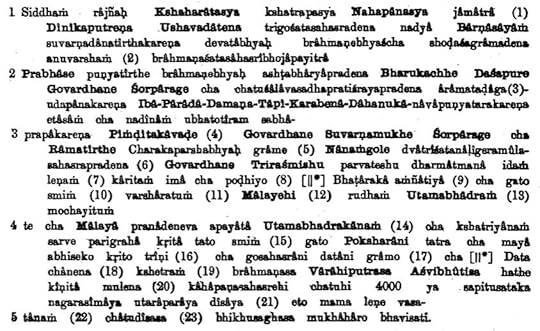 [ Epigraphia Indica vol 8 ]
[ Epigraphia Indica vol 8 ]स्वाभाविक है कि ये मालव रेगिस्तान पार 300 मील दूर के पंजाब से नहीं बल्कि पास ही किसी क्षेत्र से आए थे । कहाँ से? उत्तर दूसरे अभिलेख में है, तीसरी सदी ईस्वी का नान्दसा यूप । ये अजमेर के नीचे दक्षिण पूर्वी राजस्थान (भीलवाड़ा) से है मिला है, ना कि पंजाब से । यहाँ दोहरा दें कि पूरे मध्यकाल में दक्षिणपूर्वी राजस्थान और गुजरात से लगा हुआ केंद्रीय भारत का क्षेत्र ही मालवदेश कहलाता था ।
तीसरी सदी के ही “मालवानां जयः” युक्त सिक्के केंद्रीय भारत और दक्षिण पूर्वी राजस्थान में ही मिलते हैं, ना कि पंजाब में । सातवीं सदी के हुएन त्सांग, कादम्बरी व हर्षचरित भी मालव शब्द से केंद्रीय भारत के प्रांत का ही अर्थ देते हैं ।
महाभारत और वराहमिहिर के वर्णन से मालव नामक किसी देश को पंजाब में निश्चित रूप से स्थित करना संभव नहीं | उदाहरण के लिए महाभारत में नकुल का पांडवों के राज्य से पश्चिम को जो अभियान बताया गया है, उसमें आए त्रिगर्त को विद्वान कांगड़ा मानते हैं जो उत्तर में स्थित है, उसी तथाकथित पश्चिमी सूची में दशार्ण क्षेत्र (मध्यप्रदेश) और चित्तोड़ के पास की माध्यमिका भी है, जो कि दोनों ही हस्तिनापुर से दक्षिण को हैं | जैसा कि मानचित्र से स्पष्ट है, दशार्ण तो मध्यकालीन मालवदेश के भी पूर्व की ओर पड़ता है | ऐसे में महाभारत के मालव क्षेत्र को पंजाब में किस प्रकार मान लिया जाए?
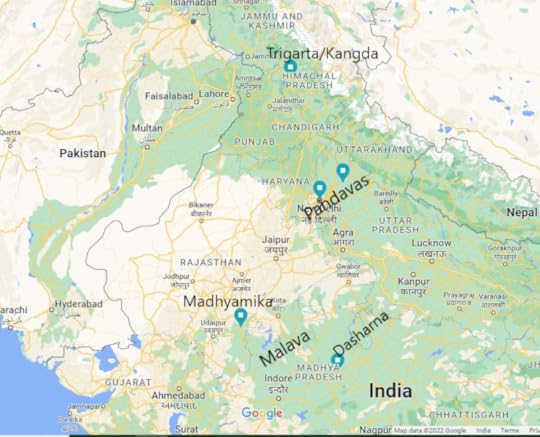
 [ Mahabharata Sabha Parva, Ch-32 ]
[ Mahabharata Sabha Parva, Ch-32 ]जब मालवदेश (मालवा) के किसी भी मध्यकालीन शासक/वंश ने ना तो अपने आप को उत्पत्ति से मालव कहा है, और ना ही पंजाब से पलायन करने मध्यभारत (मालवा/अवन्ति) आने की बात की है । तो भला होगा यदि ज़बरदस्ती की इन अटकलों को विराम दिया जाए, कि पहले से व्यथित भारतीय इतिहास और छलनी ना हो ।
मालव नामक किसी वंश/जनजाति के पंजाब से केंद्रीय भारत में आकर अपने नाम से मालवदेश (मालवा) बसाने की बात कुछ विद्वानों का अंदाज़ा भर हैं, स्थापित तथ्य नहीं | पर एक बार को यदि पंजाब से भीतर को हुए इस तथाकथित मालव पलायन को सत्य मान लें | तब भी चौहानों पर ऐतिह्य सामग्री की इतनी भी कमी नहीं है कि हमें ऐसे तुक्के लगाने पड़ें | शिलालेख, वंशावलियाँ, महाकाव्य, जैन प्रबंध आदि अनेकों स्त्रोत है | चौहान यदि मालव थे तो उनके पास अपने आप को स्पष्ट रूप से ऐसा कहने का पर्याप्त अवसर था | लेकिन इन सभी स्त्रोतों में चौहानों के द्वारा हमेशा अपने समकालीन मालवदेश के शासकों और निवासियों को “मालव” कहने और स्वयं को कभी मालव ना कहने से ही स्थिति स्पष्ट हो जाती है कि वो खुद को उत्पत्ति से मालव नहीं मानते थे |
July 2, 2022
History and Historiography on Prithviraj Chauhan – a course of conflict
History and Historiography run ante, specially when it comes to Prithviraj Chauhan. Our ‘intellectual elite’ which cries about interventions in the memory of historical figures, have ended up committing the same interventions themselves.
Many reviews appeared (at Quint, Wire, etc) recently, regarding a movie/serial on Prithviraj Chauhan. Some exhibited an arrogant, forceful criticism for the sake of it. Others were subtle, subversive propaganda than frank expression. Regardless, in hitting a Bollywood soup of history-fiction, history became the bigger casualty. These reviews, when talking of history, haven’t stuck to facts. We set the record straight on their distortions.
1. Quoting Cynthia Talbot a review says that colonial era onwards Prithviraj became popular first as a Rajput hero, then as a nationalist hero to suit the narratives of anti-British struggles, and later as a Hindu hero for the post-independence Indian politics.

Putting British era writers aside, and we’ll come to the Hindu factor later. Prithviraj Chauhan’s kingdom was in the northwest, but he became a popular trans-regional figure in the medieval age even before the Mughals arrived. At the junction of 14th-15th century CE comes HammirMahakavya of Nayachandra Suri. It covers Prithviraj’s feats in detail and was written as part of a challenge in the Tomara ruler’s court (Gwalior) from central India.
This text and various other Jain Prabandhas of 14th-15th century Gujarat (like PrabandhaChintāmani) cover Prithviraj and display a vivid geographic knowledge of India’s northern and western halves. As their authors were Jain scholars habitually travelling the Indian expanse via numerous Gachchas (monastry), it is certain that Prithviraj Chauhan’s story was equally well-traveled.
2. These reviews are marred with contradictions. For example after saying that Prithviraj Chauhan was popularized as a Rajput and National hero only the British onwards. It is also said that Prithviraj is portrayed as a villain (thus popular) in a central Indian regional epic of Alha-Udal from the Mughal era.

3. Even in that portrayal, the factual errors galore. They profile Alha-Udal’s lore as popular in ‘non-Rajputs of Rajasthan’. Reality? The story originated and circulated in Bundelkhand. Up to 19th century CE it wasn’t popular in Rajasthan. Worse, such distortion looks like a surreptitious attempt to sow divisions by mis-interpretating the regional polarity as a social one, pitting ‘monstrous feudal Rajputs’ at one end and the non-Rajput ‘peasant’ classes on the other.
The imaginary atrocity literature doesn’t acknowledge basic historical facts. Like the battles of Prithviraj’s Mahoba campaign in central India (used in the claim) were, according to the Alha-Khand as well, fought between Rajputs on both sides – Chauhans on one and Chandellas-Gahadavalas-Banaphars on the other end.

4. Reviewers’ charge that the primacy given to Raso has robbed other narrating variants of due place, is again wrong. Like Raso was popular in/around Rajputana. Alha Udal had been popular in base area – Bundelkhand. Acharya Merutunga’s near contemporary Prabandha Chintamani was written in Gujarat, covering Prithviraj in detail. Its narrative is different from Raso, and isn’t robbed of anything.
Comparing Raso and Alha stories in political context falls in the apple and orange category of unfair. Because one sits on a historical base while the other on folk. Reasons are many for why, as compared to Alha-Udal, the story of Prithviraj went trans-regional and gradually very popular (national):
a) Simple language, relatable story by which the Raso made Prithviraj immortal. In relative popularity even the contemporary & more reliable PrithvirajVijaya fades as it is in chaste Sanskrit, to which the medieval masses were increasingly out of touch.
b) Prithviraj’s story (Raso & otherwise) got ample corroboration in contemporary native+foreign literature and inscriptions of/around the 12th century AD. But the old Hindi story of Alha-Udal lacks corroborative evidence from the 12th century and has surfaced around/after the 16th century Raso.
c) Hindu Royals’ patronage to Raso.
d) Prithviraj’s proven clash with the known nemesis of medieval India – invaders from the northwest. His connection to Delhi which became an important centre during Turkish Sultanate rule.
e) Prithviraj’s kingdom, political stature being larger than Alha-Udal.
5. Then there are baseless dismissals calling Prithviraj an ‘immobile fatso’ and his nationalist hero portrayal a modern construct.
But Nation-state the way we know it today is itself a modern construct. Anyway, reasons of Prithviraj being famous and a Hindu civilizational hero, since long before 20th century politics, are factually borne in his actions:
a) Per PrithvirajVijaya when the rapacious hordes of Ghori had ravaged all from Bikampur to Nadol (in 1178 CE). Chauhan scion had strongly rebuffed the Ghurid proposal to ally with them. Prithviraj reiterated his ancestral vow to exterminate mlechhas. Though his kingdom wasn’t the prime target, and Ghurid destruction took place in locations under vassalage of rival Solankis. Yet when Nadol (another kingdom) fell, the furious Prithviraj stood up for battle. How and why the teenage King was overruled is a separate matter.
b) Based on the HammirMahakavya, Phalodi Mata temple inscription, Kalpasutra colophon we find that in 1182-83 CE when other Hindu Kingdoms outside his reign were trampled under Ghori’s torture. Prithviraj promised to lay Ghori prostrate and repent-full. He sped out of his Kingdom in full force, charged on Ghurids and captured Ghori.
Clearly Prithviraj’s thoughts, actions weren’t reserved just for his Kingdom.
c) Indian & foreign sources converge that in Ghurid captivity, other than torture, Prithviraj received lucrative offers of submitting as a vassal of Ghori. Thus save his life and throne. But the safety and honour of this country’s people were not on table. All such offers were obviously discarded and eventually led to his death.
d) Prithviraj demonstrates wider perspective and awareness when he repairs the relations with Tomaras of Delhi that had gone sour since the death of Vigraharaj Chauhan (married in Tomaras via princess Desaladevi). Later we see Tomaras fighting beside Chauhans shoulder to shoulder in both the Tarain battles.
Jain texts narrate that the Chauhan king ceased the past few years’ bitter, sporadic sparring with the Solankis of Gujarat. Despite having an upper hand, Prithviraj concluded a peace treaty with Solankis in 1186 CE. It brought crucial peace on his southern front.
All this for what? Obviously Prithviraj had sensed a far heavier issue on the northwestern horizon.
6. Movie/serial reviewers tell us that Ghori the foreigner has been quickly (deliberately) turned into a Muslim.

Is it? Before Tarain-II, Ghori’s message to Prithviraj Chauhan as per contemporary Taj-ul-Maasir and also Ferishta was :
“to place in his ear the ring of slavery to the sublime court, and embrace the faith of Islam by repeating the precepts of the law”.
This message, according to these very texts, was rebuked and rejected by the Rajput King with equal insult.
Abdul Malik Isami’s says that Tarain-II was a Hindu-Muslim clash and the Hindus fought bravely.
 Mid 14th century Futuh-us-Salatin
Mid 14th century Futuh-us-SalatinOn our side the 15th century Kanhad De Prabandha and 16th century Raso clearly profile the locals like Chauhans as Hindus and the foreigner invaders as Muslims (pair-words like Hindu-Turk are frequent in these texts in the context of conflicts).


It baffles that when the foreigners were indeed Muslim and appeared here declaring themselves as such, according to their own histories, we still resist from the proverbial spade. What else to call them, Martians?
When these invaders challenged our ancestors to either accept Islam and subordination, or die. When our ancestors refused to bow before this fanaticism. How can we tell, nay, delude ourselves that a religious polarity didn’t sprout amidst the vagaries of these medieval invasions.
7. Reviews also accuse that after Ghori being painted an uncivilized ruler, his forces are shown raiding Indian countryside mercilessly. They say that this way – “the Muslim army is othered and villified” for undue and retrospective polarisation.

Saddening indeed that poor Shahabuddin Ghori has been villified and othered. Despite the Kharatara-Gachcha-Vrihad-Gurvavali (below) informing how the travelling Jain Archarya Jinapati Suri ji suffered immeasurably for months in Ajmer because the city was still being innocently ravaged by the Islamic hordes of Ghori in 1994 CE, two years after the Tarain-II battle.

Lets apologize for Rajasthan’s Jain monks flaming fanaticism by hiding their God’s idols in desert sand because Prithviraj had been killed and Ghori was in control of the kingdom (early 14th century KanyāNayaniya Mahavir-Pratimā Kalpa below). Silly that they were spooked, after all Ghori’s mlechhas were only on tourist visa or at best a political mission, not for destroying the Sarasvati Kanthābharana complex as the marauders claim themselves.
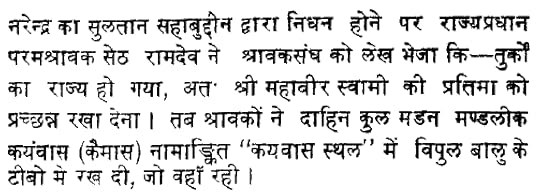
Contemporary history ‘PrithvirajVijaya’ doesn’t name Ghurids as just another rival force, rather as – cow killers, Rahu-like eclipse to civilization. None reading PrithvirjaVijaya, HammirMahakavya can miss the contrast in conventional rhetoric against rival Hindu entities and that with which the Ghurids are treated.
 PrithvirajVijaya, Chapter-11, verse 41
PrithvirajVijaya, Chapter-11, verse 41
 PrithvirajVijaya, Chapter-11, verse 43
PrithvirajVijaya, Chapter-11, verse 43Unpleasant to ‘intellectual elite’, but hard fact is that our medieval ancestors didn’t have the luxury of being high on the shallow Utopian lectures of secularism prevalent in these times.
In the name of criticizing movies/serials, these reviews counter-productively continue defacing Indian history and its inheritors.
The unlearned eminences and their endless sermons on our History
We haven’t forgotten the infamy of Quint’s recent review, supposedly of the movie on Prithviraj Chauhan, and covertly of our medieval history.
There is yet another history hit job from the eminences, or their minions? This time published in the Wire.
https://thewire.in/history/chali-kahani-the-myths-and-tales-of-prithviraj-chauhan
Given below are some pearls of wisdom from the article that we must contemplate upon.

Wrong, forget about Tod and the British. Prithviraj was a popular figure outside medieval Rajasthan even before Mughals arrived. The Hammir Mahakavya of Nayachandra Suri was written by the inspiration of a challenge laid out in the Gwalior court of a Tomara ruler from central India.
The author is also contradicting herself. She first says that Prithviraj was popularized as a Rajput and national hero only by the British (already falsified by Hammir Mahakavya).
And then later also says that Prithviraj is portrayed as a villain (thus popular) in a central Indian regional epic of Alha-Udal.
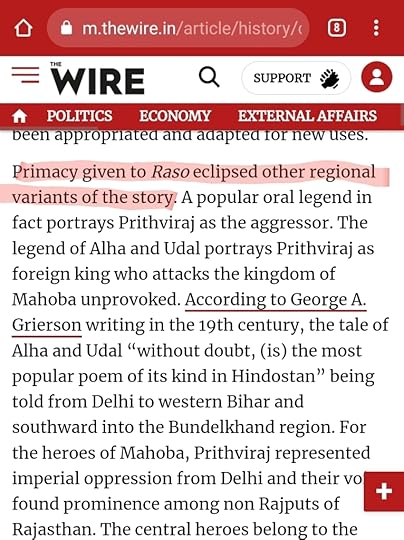
So Prithviraj is glorified in Hammir Mahakavya of central India at the junction of 14th-15th century. He is again amply portrayed in the 16th century Raso, Ferishta and 17th century Alha Udal epic.
Yet according to her Prithviraj is popularized as a Rajput hero and then national hero, only by the British and subsequent modern political currents.
Yeah, whatever you say your excellency!
She is again wrong in saying that Alha Udal was famous among non-Rajputs of Rajasthan. The epic belongs to Bundelkhand and till 19th century it was famous in central India, not Rajasthan. Is this not an attempt at polarising the people between “oppressive” Rajputs and non-Rajput peasantry? When facts are that on both sides in the story’s Mahoba campaign it was Rajputs fighting. The same “polarization” they keep screaming about day & night.
Moving on …
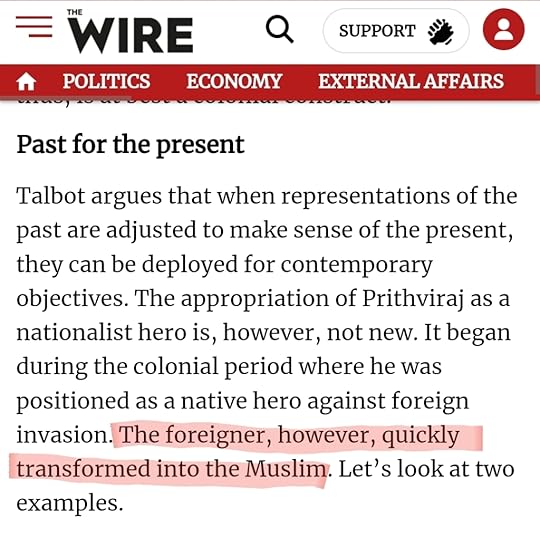
Ghori’s message to Prithviraj Chauhan as per Taj-ul-Maasir and Ferishta was:
“to place in his ear the ring of slavery to the sublime court, and embrace the faith of Islam by repeating the precepts of the law”.
This message, according to these very texts, was rebuked and rejected by the Rajput King.
When the foreigner was indeed a muslim and appeared here declaring themselves as such according to their own histories, what else do you want to call them. Martian?
When they challenged us to either accept Islam and subordination, or die.
When our Kings refused to bow before Islam and its propagating ruler.
When the contemporary histories like PrithvirajVijaya and the ones that follow- HammirMahakavya, Kanhad De Prabandha, etc profile the foreigners as cow killers and muslims (we’ve already seen examples while debunking another such hit job – https://twitter.com/virendrarathore/status/1534454281058693120).
You still say it wasn’t Hindu versus Muslim? Seriously, what are these people smoking!

Oh poor Ghori has been villified and othered. Tch Tch Tch !!
May be we should scold the travelling Jain head monk Jinapati Suri ji who suffered in Ajmer for months because muslims of Ghori were still innocently ravaging the city in 1194 AD, full two years after the battle of Tarain-II. Not good Suri ji, you’re being Nupur like.

Or may be we should reprimand those fanatic Jain monks who (according to near contemporary KanyaNayaniya Mahavir Pratima Kalpa) were trying to hide their God’s idols in desert sand because Prithviraj had been killed and Ghori was in control of the kingdom. How paranoid and silly of them indeed. After all Ghori’s mlechhas were only on tourist visa or at best a political mission.
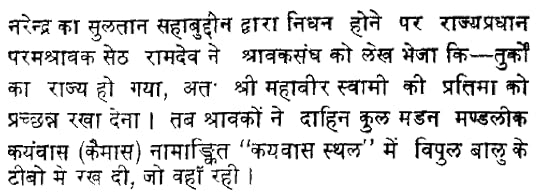
Reason why these hit jobs are ridiculous and infuriating is that in the name of trying to criticize a Bollywood movie (who cares about it anyway). They are defacing the history of this country and its people. Despicable and cheap to say the least. But then what to expect from people who per their own admission have only a transactional affinity with their last name and its history.

June 8, 2022
Vandalising the History by motivated forceful reviews
There was a six point review from Quint, of the recently released movie on Prithviraj Chauhan.
It looks like a coercive critique done just because you want to do it.
Let’s poke more than six holes in this so called six pointer review.
First of all, why would you go looking for “historical accuracy” in a Bollywood film, that too when it makes no such claims. Necessity to make a video for social media?
Second, the “academic” reviewer in this video claims that the movie has omitted a battle between Prithviraj and Jaichand where Prithviraj was badly defeated and fled to Delhi.
Fact? There was no battle “between Prithviraj Chauhan and Jaichandra Gahadavala”. Not in any other text and not even in the Raso.
The only fleeing in Raso is when Jaichandra’s forces chased Prithviraj’s hopelessly small and covert entourage (more like a surgical strike party) fleeing with Sanyogita from Kannauj to Delhi. And that retreat with Sanyogita I believe is shown in the movie.
In Mahoba khand which came even after Raso, a part of Jaichandra’s forces are said to have participated against Prithviraj’s invading army, to support the local Chandella ruler. In this battle as well the defending. Chandella army was eventually routed by Chauhans after which the Chandella ruler had to surrender and sign a peace treaty.
So there’s no “Prithviraj vs Jaichandra” battle where the former flees. The two kingdoms didn’t even share a border.
Moreover when the fleeing couple had entered Chauhan territory, the Kannauj King recalled his forces and sent dowry, other ritual items to the wedding of his daughter. Prithviraj vs Jaichandra battle you say?
 Prithviraj Raso
Prithviraj RasoThird, she says that the movie doesn’t remain true to the Prithiviraj Raso it is based on, and then rues the fact that the movie is focused on Delhi. Guess which source focuses the narrative on Delhi – Prithviraj Raso. All other preceding ones focus on Ajmer.
Fourth, “Prithviraj lost Tarain-II rather swiftly” she says. The battle of Tarain-II began at dawn. While Abdul Malik Isami of Futuh-us-Salatin grudgingly admits that the kafirs fought bravely.

The combined understanding from Maulana Ufi’s Jawami-ul-Hiqayat and Ferishta’s account is that the when it was afternoon and the battle was still fought hard. The Sultan had to call in his reserve forces of 12,000 Mamluk heavy cavalry to go for final kill and end the long drawn battle.
Not only that, it is further corroborated by the fact that almost none of the Indian combatants survived the battlefield that day, which every muslim source ratifies and the Hindu sources confirm in saying that the Rajput army that went into the battle that day was smaller than Tarain-I and not the full force.
Swift losers are the ones who flee the battlefield at sight of death, not those who fight till the last man’s last breath and die as martyrs. What an insult to the Indian sacrifice and then the gumption to proclaim that she was disappointed from the movie as an Indian.
Fifth, she says Prithviraj was captured and sent to Ajmer to rule as a vassal of Ghori. Why the vassalage was a lie is something I have detailed in the book using contemporary and near contemporary sources. It is not something that can be properly transmitted after ruthlessly squeezing in a twitter thread.
Sixth, she says that the movie is unduly and retrospectively polarising Prithviraj’s history on Hindutva-Islam whereas Prithviraj has not been called a Hindu anywhere.
While Hindu-Muslim polarity wasn’t the only factor driving the medieval politics, it certainly existed as a key one. I will share only few instances of how Prithviraj Raso, the supposed basis of this movie, as well as the Kanhad de Prabandh dated before Raso have both projected the Chauhan struggle on a Hindu-Muslim polarity.
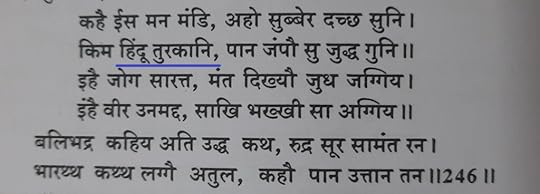


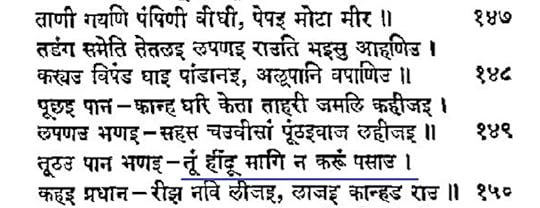 Kanhad De Prabandh 15th century
Kanhad De Prabandh 15th century
 Kanhad De Prabandh – 15th century
Kanhad De Prabandh – 15th centuryWho are these Hindusthanis of Kanhad De Prabandh Madam?

Coming to the contemporary Sanskrit texts because she says that the Hindu-Muslim polarity didn’t exist in Prithviraj Chauhan’s time. Why then is the contemporary Prithvirajvijaya calling the Ghurids as cow-killing Mlechhas and extols Chauhans as Arya and Kshatriya?

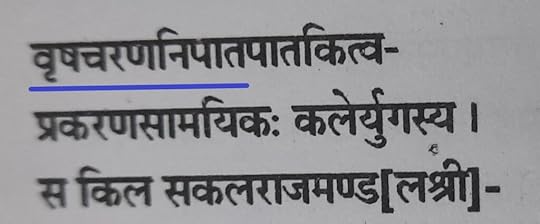

And no, Chauhan is not an ethnicity that she stated. It is rather the name of one of dozens of Kshatriya clans
Seventh, she complains that there’s no jauhar in Raso and yet they have shown it in the movie. Please wash your eyes and read. This is Sanyogita and other royal ladies entering fire to commit Sati, IN PRITHVIRAJ RASO :
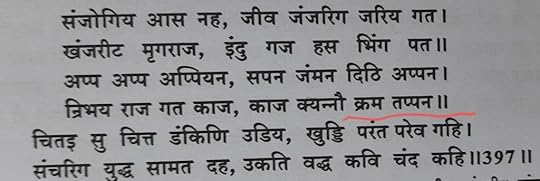

The other “this ahistorical that ahistorical” bickerings around marble palaces, type of arenas, too many Farsi words and window patterns, etc are innuendos. They shouldn’t be placed if you have already relayed the awareness that the movie is based on 16th century Raso. The reviewer should have at least educated herself on how many Farsi words exist in the film’s basis text – Raso. That would’ve helped from the foot in mouth utterances.
I am no fan of that movie or of the tendency of absorbing Bollywood movies as history. But this Quint review is a mockery done just for the sake of it.
July 16, 2021
‘You got it backwards!’ Reviewing a modern narration of Peshwa’s Jaipur visit.
After writing a long blogpost on how gulping the words of historical sources as is can be deceptive.
I saw this 
 https://twitter.com/kirron909/status/1415006883836923905?s=19
https://twitter.com/kirron909/status/1415006883836923905?s=19Content given to buttress this argument was a speech by Uday Kulkarni (embdedded in the tweet that is now protected). Following tweet of Kulkarni shows the gist of his assertion.
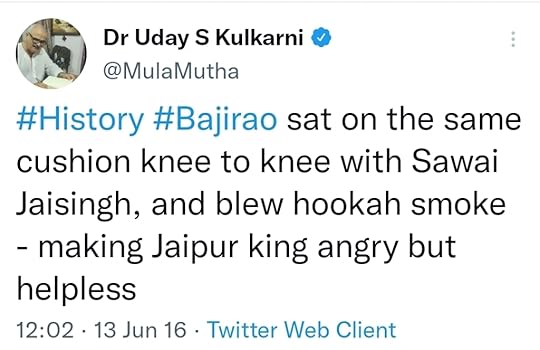 https://twitter.com/MulaMutha/status/742243135661563904?t=YORvNb4Seny6uD4uZwe5Gw&s=19
https://twitter.com/MulaMutha/status/742243135661563904?t=YORvNb4Seny6uD4uZwe5Gw&s=19In his speech, Kulkarni portrays how Peshwa’s behaviour & attitude were radically different in meeting with Mewar’s Maharana versus with Jaipur’s Sawai Jai Singh. That while meeting the Mewari Rana he sat on ground as mark of respect. But when he met Jaipur King who expected similar behaviour from Peshwa. Latter highlighted the house’s Mughal alliance and stressed that it wasn’t deserving of behaviour at par with how he had treated Mewar royalty. Further details of what he said and where he draws it from will be covered below.
I will not get into the Mewar visit as it has been commented upon by others elsewhere.
"The Peshwa was friendly to the Rana of Udaipur as he considered him greater to other Rajputs and was equal to the Raja of Satara (Chhatrapati) because he never accepted the Mughal as master." ~ AN UTTER CHITPAVAN SAVARKARITE LIE pic.twitter.com/rsp7Q8lUXw
— Yashasvī Pratāp (@yashasvipratap) May 20, 2020
Coming to Peshwa’s Jaipur visit.
Just before his visit to Jaipur. Peshwa’s Matushri Radha Bai plus her entourage’s pilgrimage and months long stay in Rajputana were completely and thoroughly looked after by Sawai Jai Singh. All this was amidst an ongoing Mughal-Maratha hostilities.
Peshwa’s envoy named Mahadeo Bhatt Hingne was already deputed in Jaipur. Following is from his journal of correspondences & tafsils called the Hingne Daftar.
 Hingne Dafter, vol 1, letter no. 19
Hingne Dafter, vol 1, letter no. 19
 Hingne Dafter, vol 1, letter no. 19
Hingne Dafter, vol 1, letter no. 19 Basically it says that Radha Bai and Jai Singh’s relation was like mother and son. Jai Singh personally hosted her. Kept a sizeable army for her protection all the time throughout Rajputana and up to Agra. He attached his officers and diplomats for her convenience during further travel. Due to all this, not only was there a positivity in the bilateral relations. But Jai Singh and Peshwa’s tuning became brotherly. In the same vein it even speaks of Marathas being of one mind with “Sawai Ji” (Jai Singh) on the matter of pilgrimage centres and stopping cow slaughter
This is not my but eye witness Hingne’s narration.
For further clarity, I am also attaching parts of what Shri G S Sardesai has said on the matter.


This is further reinforced by the Selections from Peshwa Daftar vol 30, No. 131.
Another contemporary (a Rajput source this time) covering this visit is the Dastur Komwar records of Jaipur Archives. They also don’t say anything to the contrary.
Considering this evidence. We don’t know what to do with the hearsay that is being sold as history in the video. Like Jai Singh expecting Peshwa to sit down at his feet and Peshwa treating him like an out-caste. It completely deviates from the entire political background of past few decades before this event. As if Jai Singh wasn’t some astute Statesman (Maratha sources respectfully call him so). But was some clueless person who had suddenly dropped in that world out of nowhere.
Contrary to what Kulkarni says. Peshwa and the Raja didn’t personally discuss the protocols of the meeting that BajiRao would utter something like this. It doesn’t happen this way anywhere. That discussion is something that, as a norm, was and is always handled by the respective envoys and ministers.
There is no reason to deduce any such lack of cordiality between Jai Singh and the Peshwa. The importance and regard that BajiRao and even his successor gave to Sawai Jai Singh is not a secret and exhibits sufficiently in contemporary literature as well as works of later stalwarts like G S Sardesai.
Sawai Jai Singh was the linchpin in the political transactions between Mughals and Marathas during the first half of 18th century.
This is BajiRao’s successor Balaji writing to envoy Hingne few years later.

For the gossip repeated at video, on both the Mewar visit as well as Jaipur. The first place where it appears is the Bundi bard’s Vansha Bhaskar completed in the late 19th century. Neither on the place nor on the time of events (1736 AD). It quotes Peshwa to have said “You are subordinate to greed and mlechhas. I’m superior to you. But today we meet as equals. Don’t think that I will leave my seat and sit below you. I will sit on the right and you on the left…”.
Then it continues to narrate that Peshwa uses hukkah and puffs the smoke on Jai Singh.

Not only was the Bundi poet telling this tale from well more than a century away. He didn’t even have direct access to Mewari documents to scrutinize the second hand data he may have received verbally or bardically, about the Peshwa’s Mewar visit.
It should be asked from Kulkarni why he didn’t properly analyze whether this narration was credible or not. But ofcourse when it gelled with whatever he wanted to present as history to his audience, so be it. The contradictions in the speech are hilarious. Peshwa and Jai Singh were together for more than two months. And at the same time Peshwa is puffing smoke into Jai Singh’s face during meeting. Observe this in the background of relations per Hingne’s data and the visit of Peshwa’s mother. A classic example of ‘You got it backwards!’
Despite mentioning the visit of Matushri Radha Bai in his speech. Kulkarni doesn’t do the obvious 2+2, omits the contemporary Marathi evaluation of Jai Singh; and goes on portraying as if Peshwa treated Mewari and Jaipur royalty in opposite manners.
Smoke aside, if one really wanted to know what the Peshwas thought of Sawai Jai Singh. They could easily find from contemporary Marathi sources like Peshwa Daftar and Hingne Daftar.
But no, pushing a tilted narrative is more important. Even if it is a stranger to the truth.
This was another retrofitting of modern and biased conclusions into the events of past. Effort to sell it in the name of Hindutva compels for scrambling for data aligning with the pre-conceived notions. Ending up with the use of sources that don’t even fit the requirement at hand.
It is disappointing to see that people would byepass the logical choice of easily available primary sources that overlap the events by time and place. And instead refer to third (fourth actually) party accounts like the Bundi annals written later in the 19th and early 20th century. Takes no labour to understand that all this is just to shove some heavily colored agenda or narrative.
Accepting such polarizing portrayal at face value. One would be forced to believe as if the Peshwa was some milord judging who among the plebs passes the Hindutva test.
What is it, if not a travesty of history.
Narration of Peshwa’s Jaipur visit. You got it backwards!
After writing a long blogpost on how gulping the words of historical sources as is can be deceptive.
I saw this 
 https://twitter.com/kirron909/status/1415006883836923905?s=19
https://twitter.com/kirron909/status/1415006883836923905?s=19Content given to buttress this argument was a speech by Uday Kulkarni (embdedded in the tweet that is now protected). There, Kulkarni portrays how Peshwa’s behaviour & attitude were radically different in meeting with Mewar’s Maharana versus with Jaipur’s Sawai Jai Singh. That while meeting the Mewari Rana he sat on ground as mark of respect. But when he met Jaipur King who expected similar behaviour from Peshwa. Latter highlighted the house’s Mughal alliance and stressed that it wasn’t deserving of behaviour at par with how he had treated Mewar royalty. Further details of what he said and where he draws it from will be covered below.
I will not get into the Mewar visit as it has been commented upon by others elsewhere.
"The Peshwa was friendly to the Rana of Udaipur as he considered him greater to other Rajputs and was equal to the Raja of Satara (Chhatrapati) because he never accepted the Mughal as master." ~ AN UTTER CHITPAVAN SAVARKARITE LIE pic.twitter.com/rsp7Q8lUXw
— Yashasvī Pratāp (@yashasvipratap) May 20, 2020
Coming to Peshwa’s Jaipur visit.
Just before his visit to Jaipur. Peshwa’s Matushri Radha Bai plus her entourage’s pilgrimage and months long stay in Rajputana were completely and thoroughly looked after by Sawai Jai Singh. All this was amidst an ongoing Mughal-Maratha hostilities.
Peshwa’s envoy named Mahadeo Bhatt Hingne was already deputed in Jaipur. Following is from his journal of correspondences & tafsils called the Hingne Daftar.
 Hingne Dafter, vol 1, letter no. 19
Hingne Dafter, vol 1, letter no. 19
 Hingne Dafter, vol 1, letter no. 19
Hingne Dafter, vol 1, letter no. 19 Basically it says that Radha Bai and Jai Singh’s relation was like mother and son. Jai Singh personally hosted her. Kept a sizeable army for her protection all the time throughout Rajputana and up to Agra. He attached his officers and diplomats for her convenience during further travel. Due to all this, not only was there a positivity in the bilateral relations. But Jai Singh and Peshwa’s tuning became brotherly. In the same vein it even speaks of Marathas being of one mind with “Sawai Ji” (Jai Singh) on the matter of pilgrimage centres and stopping cow slaughter
This is not my but eye witness Hingne’s narration.
For further clarity, I am also attaching parts of what Shri G S Sardesai has said on the matter.


This is further reinforced by the Selections from Peshwa Daftar vol 30, No. 131.
Another contemporary (a Rajput source this time) covering this visit is the Dastur Komwar records of Jaipur Archives. They also don’t say anything to the contrary.
Considering this evidence. We don’t know what to do with the hearsay that is being sold as history in the video. Like Jai Singh expecting Peshwa to sit down at his feet and Peshwa treating him like an out-caste. It completely deviates from the entire political background of past few decades before this event. As if Jai Singh wasn’t some astute Statesman (Maratha sources respectfully call him so). But was some clueless person who had suddenly dropped in that world out of nowhere.
Contrary to what Kulkarni says. Peshwa and the Raja didn’t personally discuss the protocols of the meeting that BajiRao would utter something like this. It doesn’t happen this way anywhere. That discussion is something that, as a norm, was and is always handled by the respective envoys and ministers.
There is no reason to deduce any such lack of cordiality between Jai Singh and the Peshwa. The importance and regard that BajiRao and even his successor gave to Sawai Jai Singh is not a secret and exhibits sufficiently in contemporary literature as well as works of later stalwarts like G S Sardesai.
Sawai Jai Singh was the linchpin in the political transactions between Mughals and Marathas during the first half of 18th century.
This is BajiRao’s successor Balaji writing to envoy Hingne few years later.

For the gossip repeated at video, on both the Mewar visit as well as Jaipur. The first place where it appears is the Bundi bard’s Vansha Bhaskar completed in the late 19th century. Neither on the place nor on the time of events (1736 AD). It quotes Peshwa to have said “You are subordinate to greed and mlechhas. I’m superior to you. But today we meet as equals. Don’t think that I will leave my seat and sit below you. I will sit on the right and you on the left…”.
Then it continues to narrate that Peshwa uses hukkah and puffs the smoke on Jai Singh.

Not only was the Bundi poet telling this tale from well more than a century away. He didn’t even have direct access to Mewari documents to scrutinize the second hand data he may have received verbally or bardically, about the Peshwa’s Mewar visit.
It should be asked from Kulkarni why he didn’t properly analyze whether this narration was credible or not. But ofcourse when it gelled with whatever he wanted to present as history to his audience, so be it. The contradictions in the speech are hilarious. Peshwa and Jai Singh were together for more than two months. And at the same time Peshwa is puffing smoke into Jai Singh’s face during meeting. Observe this in the background of relations per Hingne’s data and the visit of Peshwa’s mother. A classic example of ‘You got it backwards!’
Despite mentioning the visit of Matushri Radha Bai in his speech. Kulkarni doesn’t do the obvious 2+2, omits the contemporary Marathi evaluation of Jai Singh; and goes on portraying as if Peshwa treated Mewari and Jaipur royalty in opposite manners.
Smoke aside, if one really wanted to know what the Peshwas thought of Sawai Jai Singh. They could easily find from contemporary Marathi sources like Peshwa Daftar and Hingne Daftar.
But no, pushing a tilted narrative is more important. Even if it is a stranger to the truth.
This was another retrofitting of modern and biased conclusions into the events of past. Effort to sell it in the name of Hindutva compels for scrambling for data aligning with the pre-conceived notions. Ending up with the use of sources that don’t even fit the requirement at hand.
It is disappointing to see that people would byepass the logical choice of easily available primary sources that overlap the events by time and place. And instead refer to third (fourth actually) party accounts like the Bundi annals written later in the 19th and early 20th century. Takes no labour to understand that all this is just to shove some heavily colored agenda or narrative.
Accepting such polarizing portrayal at face value. One would be forced to believe as if the Peshwa was some milord judging who among the plebs passes the Hindutva test.
What is it, if not a travesty of history.
July 10, 2021
List of social media appearences
The Progressive Rajput
Appeared at my friend Harshavardhan Singh’s Youtube channel named The Progressive Rajput. Spoke about my book ‘Prithviraj Chauhan – a light on the mist in History’.
Link to the video:
Sangam Talks
This was a lecture on Prithviraj Chauhan at the platform of Sangam Talks.
It was recorded on May 01st 2021 and released on the June 07th which was celebrated as the jayanti of Prithviraj Chauhan.
Following are the links to the video uploaded on the Hindi and English channel of Sangam Talks.
Kshatriya Yuvak Sangh
On June 07th, participated in a live session where Kshatriya Yuvak Sangh was celebrating the jayanti of Prithviraj Chauhan and Harshavardhan Pushyabhuti.
Following is the link to video :
Twitter Threads
Following are the links to twitter threads where I’ve posted short clips collated from these videos.
The published videos of Sangam Talks were edited by them to keep the video duration reasonable. Hence I also wanted to share the parts that got chopped out during this editing.
This thread will be gradually appended with short clips of information on the famous Chauhan King Prithviraj III.
— वीरेन्द्र सिंह राठौड़(मेड़तिया)卐 (@virendrarathore) June 13, 2021
These are taken from the recent sessions done with Sangam Talks and Shri Kshatriya Yuvak Sangh.
Another important aspect is the debate around ancestry of Prithviraj Chauhan. Following thread covers some of the evidence on it which I couldn’t squeeze in the book:
A whole chapter was dedicated in the book regarding the frivolous debate on ancestry of Prithviraj Chauhan.
— वीरेन्द्र सिंह राठौड़(मेड़तिया)卐 (@virendrarathore) June 13, 2021
We now cover some points that couldn't be included in the book's chapter. Part 1 pic.twitter.com/ZxLfopCTWK



